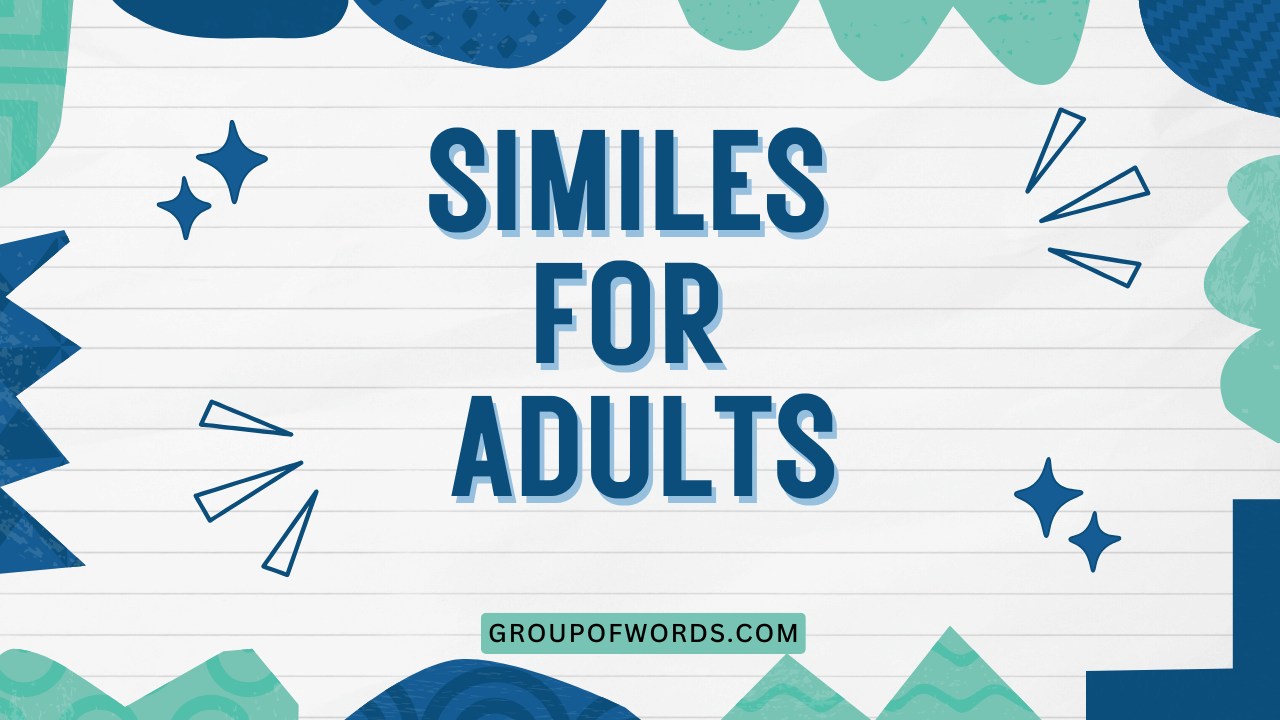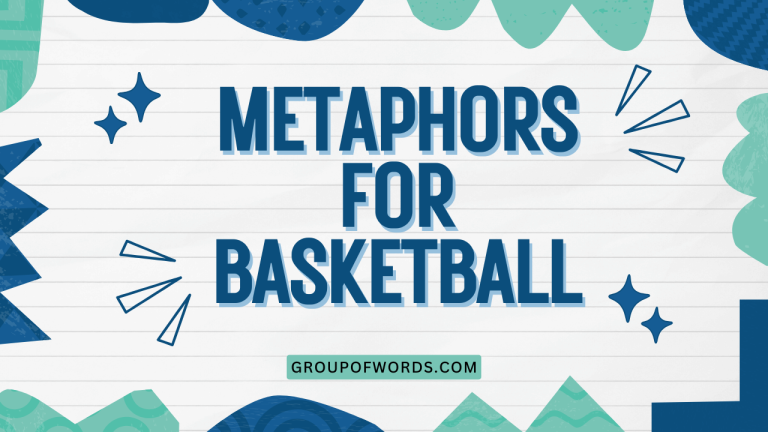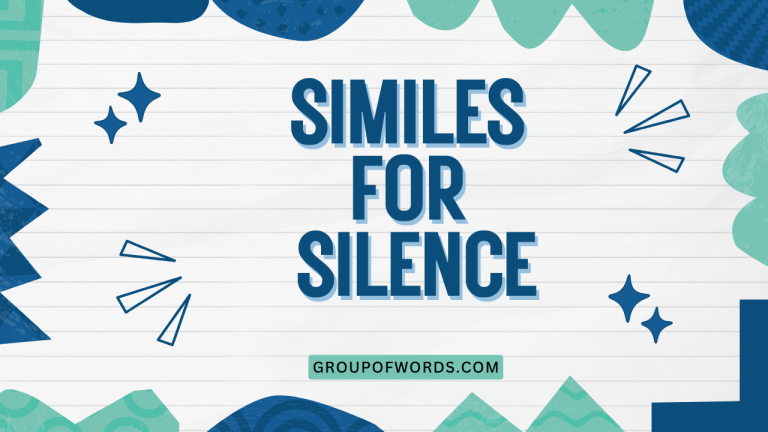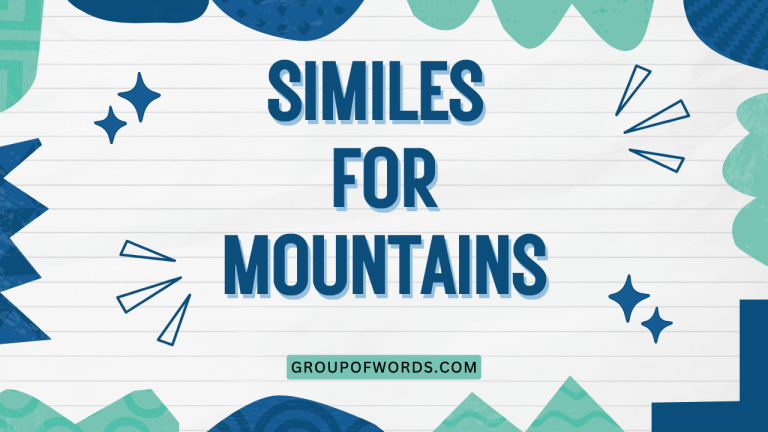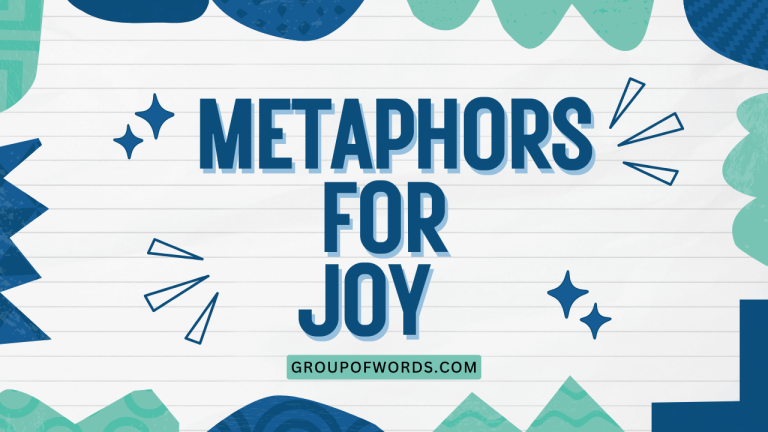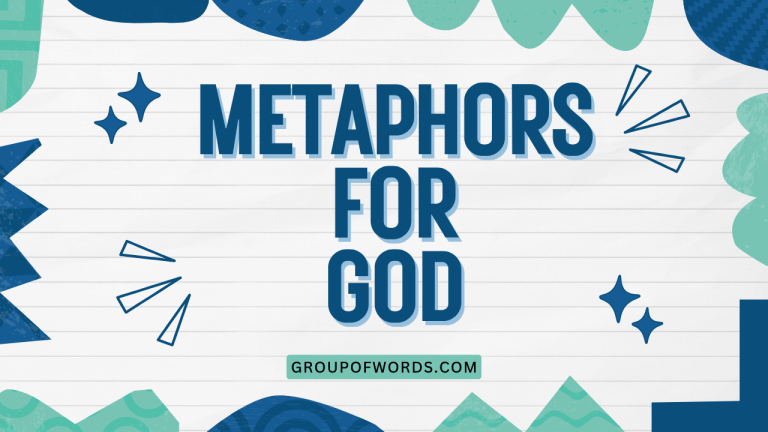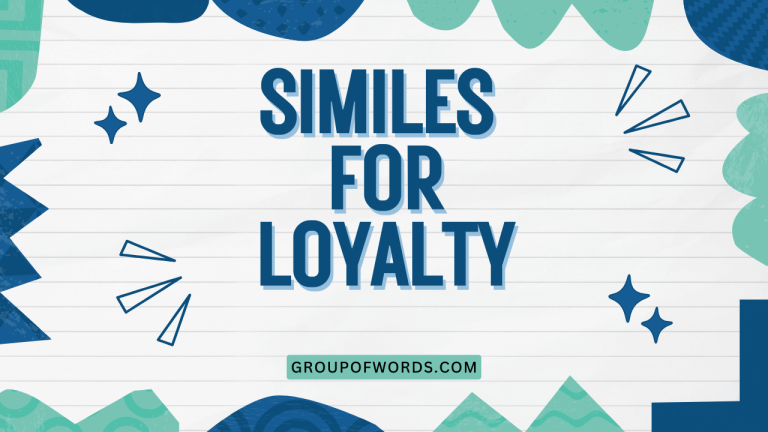Similes for Adults: Mastering Figurative Language
Similes are powerful tools in the English language, allowing us to create vivid comparisons and enhance our communication. Understanding similes is essential for anyone looking to improve their writing, public speaking, or even everyday conversations.
This article provides a comprehensive guide to similes, exploring their definition, structure, types, and usage. Whether you’re a seasoned writer or just beginning to explore the nuances of figurative language, this guide will equip you with the knowledge and skills to effectively use similes in your own expressions.
This article is designed for adult learners who want to deepen their understanding of English grammar and figurative language. It covers everything from basic definitions to advanced applications, offering numerous examples and practice exercises to solidify your learning.
By mastering similes, you can add depth, color, and impact to your communication, making it more engaging and memorable.
Table of Contents
- Definition of Simile
- Structural Breakdown of Similes
- Types of Similes
- Examples of Similes
- Usage Rules for Similes
- Common Mistakes with Similes
- Practice Exercises
- Advanced Topics: Beyond Basic Similes
- Frequently Asked Questions (FAQ)
- Conclusion
Definition of Simile
A simile is a figure of speech that directly compares two different things using the words “like” or “as.” The purpose of a simile is to create a vivid image or to emphasize a particular quality of one of the things being compared. Similes are a fundamental part of figurative language, used to make descriptions more engaging and memorable.
They allow writers and speakers to draw connections between seemingly unrelated concepts, adding depth and richness to their communication.
Similes are different from metaphors, which also compare two things but do so by stating that one thing *is* another, rather than merely *like* or *as* another. For instance, “He is brave like a lion” is a simile, while “He is a lion” is a metaphor.
Similes provide a more explicit comparison, making them easier to understand and use, especially for those who are new to figurative language. Understanding the distinction between similes and metaphors is crucial for effective communication and literary analysis.
The key elements of a simile include the two things being compared (the subject and the object of comparison) and the connecting word (“like” or “as”). The comparison should highlight a shared characteristic or quality between the two things.
Effective similes are often unexpected or imaginative, creating a fresh and insightful perspective. They can be used in a variety of contexts, from poetry and literature to everyday conversations and business presentations.
Structural Breakdown of Similes
The basic structure of a simile consists of three main components: the subject, the linking word, and the object of comparison. The subject is the thing being described or compared. The linking word is either “like” or “as,” which explicitly indicates that a comparison is being made. The object of comparison is the thing to which the subject is being compared.
The formula for a simile can be expressed as follows: Subject + Linking Word (like/as) + Object of Comparison. For example, in the simile “The night was as dark as ink,” the subject is “the night,” the linking word is “as,” and the object of comparison is “ink.” This simple structure allows for a wide range of creative expressions, as different subjects and objects can be combined to create unique and evocative comparisons.
Understanding the grammatical structure of similes is essential for using them correctly and effectively. The clarity of a simile depends on the precise and appropriate use of these components.
A well-constructed simile will not only be grammatically correct but also create a clear and impactful comparison. By mastering the structural elements of similes, you can enhance your ability to communicate effectively and creatively.
Types of Similes
While all similes share the same basic structure, they can be categorized based on their function and the type of comparison they make. Understanding these different types can help you choose the most effective simile for a particular context.
Descriptive Similes
Descriptive similes are used to paint a vivid picture of something by comparing it to something else. They often focus on sensory details, such as sight, sound, smell, taste, or touch.
These similes help the reader or listener to visualize or experience the subject more fully.
Explanatory Similes
Explanatory similes are used to clarify or explain something by comparing it to something more familiar or easily understood. They often simplify complex ideas or concepts, making them more accessible to the audience.
Emphatic Similes
Emphatic similes are used to emphasize a particular quality or characteristic of the subject. They often involve exaggeration or hyperbole to make the comparison more striking and memorable.
These similes are designed to create a strong impact on the audience.
Examples of Similes
Here are several examples of similes, categorized for clarity. These examples illustrate the versatility and power of similes in enhancing communication.
Descriptive Similes Examples
The following table provides examples of descriptive similes, showcasing how they can be used to create vivid imagery.
| Simile | Explanation |
|---|---|
| The lake was as smooth as glass. | Describes the calmness and stillness of the lake. |
| Her voice was like velvet. | Describes the softness and smoothness of her voice. |
| The snow fell like feathers. | Describes the gentle and light descent of the snow. |
| The sun was as bright as a spotlight. | Emphasizes the intensity of the sunlight. |
| The coffee tasted like burnt rubber. | Describes the unpleasant taste of the coffee. |
| His skin felt like sandpaper. | Describes the rough texture of his skin. |
| The music was as loud as a rock concert. | Highlights the high volume of the music. |
| The air smelled like freshly baked bread. | Describes the pleasant aroma in the air. |
| The fog was as thick as pea soup. | Emphasizes the density and opacity of the fog. |
| The stars shone like diamonds. | Describes the brightness and sparkle of the stars. |
| The wind howled like a wolf. | Describes the eerie and mournful sound of the wind. |
| The rain fell as hard as nails. | Emphasizes the intensity of the rainfall. |
| Her eyes were like emeralds. | Describes the vibrant green color of her eyes. |
| The silence was as deep as a grave. | Highlights the profound and unsettling quietness. |
| His laughter was like a bubbling brook. | Describes the cheerful and lighthearted sound of his laughter. |
| The fabric felt as soft as silk. | Emphasizes the luxurious texture of the fabric. |
| The city was as busy as a beehive. | Describes the bustling activity and energy of the city. |
| The dessert tasted like heaven. | Highlights the delicious and delightful flavor of the dessert. |
| The waves crashed like thunder. | Describes the loud and powerful sound of the waves. |
| The clouds were as white as cotton. | Emphasizes the pure and fluffy appearance of the clouds. |
| The old house stood as still as a ghost. | Describes the eerie stillness of the old house. |
| The soup was as hot as lava. | Emphasizes the extreme heat of the soup. |
| She moved as gracefully as a swan. | Describes the elegance and fluidity of her movements. |
| The perfume smelled like roses. | Describes the floral scent of the perfume. |
Explanatory Similes Examples
The following table provides examples of explanatory similes, showing how they can simplify complex concepts.
| Simile | Explanation |
|---|---|
| The project was like climbing Mount Everest. | Explains the difficulty and challenge of the project. |
| Understanding quantum physics is like trying to catch smoke. | Illustrates the elusive and complex nature of quantum physics. |
| Life is like a box of chocolates. | Explains the unpredictable and varied nature of life. |
| Learning a new language is like building a house. | Describes the step-by-step process and effort required to learn a new language. |
| The stock market is like a roller coaster. | Explains the volatile and unpredictable nature of the stock market. |
| Relationships are like gardens. | Illustrates the need for care and attention in maintaining relationships. |
| The internet is like a vast library. | Describes the extensive amount of information available online. |
| Managing a team is like conducting an orchestra. | Explains the need for coordination and leadership in managing a team. |
| Writing a novel is like running a marathon. | Describes the long and demanding process of writing a novel. |
| The human brain is like a computer. | Illustrates the complex processing and storage capabilities of the brain. |
| Investing in real estate is like planting a tree. | Explains the long-term growth and potential returns of real estate investment. |
| Parenting is like navigating uncharted waters. | Describes the challenges and uncertainties of raising children. |
| Politics is like a game of chess. | Illustrates the strategic and complex nature of political maneuvering. |
| The legal system is like a maze. | Explains the complicated and confusing nature of the legal system. |
| Starting a business is like riding a bicycle. | Describes the need for balance and perseverance in starting a business. |
| The scientific method is like a detective’s investigation. | Illustrates the systematic and investigative approach of scientific research. |
| Public speaking is like performing on stage. | Explains the need for confidence and preparation in public speaking. |
| Meditation is like cleaning a dusty room. | Explains the process of clearing your mind and achieving inner peace. |
| Artificial intelligence is like a growing child. | Illustrates the continuous learning and development of AI systems. |
| Sustainable living is like tending a delicate ecosystem. | Explains the need for careful balance and responsibility in environmental practices. |
| Diplomacy is like walking a tightrope. | Describes the careful balance and risk involved in international relations. |
| Solving a complex problem is like untangling a knot. | Explains the step-by-step approach needed to resolve difficult issues. |
| Building a strong team is like constructing a pyramid. | Illustrates the need for a solid foundation and collaborative effort. |
| Personal growth is like climbing a staircase. | Explains the gradual and progressive nature of self-improvement. |
Emphatic Similes Examples
The following table provides examples of emphatic similes, emphasizing qualities through exaggeration.
| Simile | Explanation |
|---|---|
| He was as angry as a hornet. | Emphasizes the intensity and ferocity of his anger. |
| She was as stubborn as a mule. | Highlights her extreme resistance to change or persuasion. |
| The pain was like being stabbed with a thousand knives. | Emphasizes the extreme severity and intensity of the pain. |
| He ran as fast as the wind. | Highlights his exceptional speed and agility. |
| She was as busy as a one-armed paper hanger. | Emphasizes her extreme busyness and activity. |
| The crowd roared like a pack of lions. | Highlights the loud and intimidating sound of the crowd. |
| He was as nervous as a long-tailed cat in a room full of rocking chairs. | Emphasizes his extreme anxiety and unease. |
| She was as quiet as a mouse. | Highlights her extreme silence and unobtrusiveness. |
| The task was as easy as pie. | Emphasizes the simplicity and ease of the task. |
| He was as strong as an ox. | Highlights his exceptional physical strength. |
| She was as brave as a lion. | Emphasizes her exceptional courage and fearlessness. |
| The joke was as old as the hills. | Highlights the extreme staleness and lack of originality of the joke. |
| He was as hungry as a bear. | Emphasizes his extreme hunger and appetite. |
| She was as happy as a clam. | Highlights her extreme happiness and contentment. |
| The wait felt like an eternity. | Emphasizes the extreme length and tedium of the wait. |
| He was as surprised as a deer in headlights. | Emphasizes his extreme shock and disbelief. |
| She was as graceful as a gazelle. | Highlights her exceptional grace and elegance. |
| The car was as fast as a rocket. | Emphasizes the exceptional speed and acceleration of the car. |
| He was as cold as ice. | Highlights his extreme lack of emotion and empathy. |
| She was as sharp as a tack. | Emphasizes her exceptional intelligence and wit. |
| The problem was as complicated as a Rubik’s Cube. | Highlights the extreme complexity and difficulty of the problem. |
| He was as tired as a dog. | Emphasizes his extreme exhaustion and fatigue. |
| She was as light as a feather. | Highlights her extreme lightness and delicacy. |
| The news hit him like a ton of bricks. | Emphasizes the overwhelming and devastating impact of the news. |
Usage Rules for Similes
While similes are relatively simple to construct, there are some important rules to follow to ensure they are used effectively and appropriately.
Clarity
The comparison made in a simile should be clear and easily understood. Avoid using obscure or unfamiliar references that may confuse the audience.
The connection between the subject and the object of comparison should be immediately apparent.
Relevance
The comparison should be relevant to the context and purpose of the communication. The simile should enhance the meaning and impact of the message, rather than detracting from it.
Choose comparisons that are meaningful and appropriate for the intended audience.
Originality
While some common similes can be effective, strive for originality in your comparisons. Overused similes can become clichés and lose their impact.
Try to create fresh and imaginative comparisons that will capture the audience’s attention and make your writing or speaking more memorable.
Consistency
Ensure that the simile is consistent with the overall tone and style of your writing or speaking. A simile that is too informal or humorous may be inappropriate in a serious or formal context.
Choose similes that align with the overall message and intended effect.
Common Mistakes with Similes
Even experienced writers and speakers can sometimes make mistakes when using similes. Being aware of these common errors can help you avoid them in your own communication.
Using Metaphors Instead of Similes
One common mistake is confusing similes with metaphors. Remember that similes use “like” or “as” to make a comparison, while metaphors state that one thing is another.
For example:
| Incorrect (Metaphor) | Correct (Simile) |
|---|---|
| He is a rock. | He is like a rock. |
| The world is a stage. | The world is like a stage. |
Using Clichés
Overusing common similes can make your writing or speaking sound unoriginal and uninspired. Avoid clichés such as “as busy as a bee” or “as blind as a bat.” Instead, strive to create fresh and imaginative comparisons.
Making Unclear Comparisons
Ensure that the comparison made in your simile is clear and easy to understand. Avoid using obscure or unfamiliar references that may confuse the audience.
For example:
| Incorrect (Unclear) | Correct (Clear) |
|---|---|
| He was as enigmatic as a quantum entanglement. | He was as enigmatic as a riddle. |
| Her instructions were as clear as a Byzantine mosaic. | Her instructions were as clear as a map. |
Using Illogical Comparisons
The comparison made in your simile should be logical and make sense. Avoid comparing things that have no meaningful connection.
For example:
| Incorrect (Illogical) | Correct (Logical) |
|---|---|
| The car was as loud as a flower. | The car was as loud as a jet engine. |
| The book was as heavy as a cloud. | The book was as heavy as a brick. |
Practice Exercises
Test your understanding of similes with these practice exercises. Identify the similes in the following sentences and explain their meaning.
Exercise 1: Identifying Similes
Identify the similes in the following sentences.
| Question | Answer |
|---|---|
| 1. The old man’s face was as wrinkled as a prune. | The simile is “as wrinkled as a prune.” It means the old man’s face had many wrinkles, similar to the texture of a prune. |
| 2. Her laughter was like the tinkling of bells. | The simile is “like the tinkling of bells.” It means her laughter was light, clear, and musical, similar to the sound of bells. |
| 3. The athlete ran as swiftly as a cheetah. | The simile is “as swiftly as a cheetah.” It means the athlete ran very fast, similar to the speed of a cheetah. |
| 4. The politician’s promises were as empty as a hollow drum. | The simile is “as empty as a hollow drum.” It means the politician’s promises were insincere and without substance, like a drum that produces a hollow sound. |
| 5. The detective moved as silently as a shadow. | The simile is “as silently as a shadow.” It means the detective moved without making any noise, similar to the way a shadow moves. |
| 6. The argument escalated like a wildfire. | The simile is “like a wildfire.” It means the argument spread quickly and uncontrollably, similar to the rapid spread of a wildfire. |
| 7. The child slept as soundly as a log. | The simile is “as soundly as a log.” It means the child slept very deeply and peacefully, like a log that is motionless and undisturbed. |
| 8. The building stood as tall as a skyscraper. | The simile is “as tall as a skyscraper.” It means the building was very tall, similar to the height of a skyscraper. |
| 9. The feeling of nostalgia washed over her like a warm wave. | The simile is “like a warm wave.” It means the feeling of nostalgia was comforting and enveloping, similar to the sensation of a warm wave. |
| 10. His temper was as explosive as dynamite. | The simile is “as explosive as dynamite.” It means his temper was unpredictable and easily triggered, similar to the explosive nature of dynamite. |
Exercise 2: Completing Similes
Complete the following similes with appropriate endings.
| Question | Answer |
|---|---|
| 1. The coffee was as bitter as __________. | The coffee was as bitter as gall. |
| 2. She was as radiant as __________. | She was as radiant as the sun. |
| 3. The crowd was as dense as __________. | The crowd was as dense as a forest. |
| 4. The problem was as thorny as __________. | The problem was as thorny as a rose bush. |
| 5. The answer was as clear as __________. | The answer was as clear as day. |
| 6. The news spread like __________. | The news spread like wildfire. |
| 7. He was as gentle as __________. | He was as gentle as a lamb. |
| 8. The task was as simple as __________. | The task was as simple as breathing. |
| 9. The fabric felt as smooth as __________. | The fabric felt as smooth as satin. |
| 10. The silence was as profound as __________. | The silence was as profound as the grave. |
Exercise 3: Writing Similes
Write your own similes to describe the following subjects.
| Subject | Example Simile |
|---|---|
| 1. A thunderstorm | A thunderstorm was like an angry giant throwing rocks at the earth. |
| 2. A crowded city street | A crowded city street was like a river of people flowing in different directions. |
| 3. A peaceful forest | A peaceful forest was like a cathedral of trees, filled with quiet reverence. |
| 4. A difficult decision | A difficult decision was like navigating a minefield, with hidden dangers at every turn. |
| 5. A happy memory | A happy memory was like a warm ray of sunshine on a cold day. |
| 6. A challenging project | A challenging project was like climbing a steep mountain, requiring endurance and determination. |
| 7. A close friendship | A close friendship was like a sturdy bridge, connecting two souls across the distance. |
| 8. A creative idea | A creative idea was like a spark igniting a fire, spreading inspiration and innovation. |
| 9. A relaxing vacation | A relaxing vacation was like floating on a cloud, free from worries and stress. |
| 10. A meaningful conversation | A meaningful conversation was like a deep dive into uncharted waters, exploring new perspectives and insights. |
Advanced Topics: Beyond Basic Similes
For advanced learners, there are several more complex aspects of similes to explore. These include extended similes, implied similes, and the use of similes in literary analysis.
Extended Similes
Extended similes are similes that are developed over several lines or even an entire paragraph. They provide a more detailed and elaborate comparison, allowing for a deeper exploration of the subject.
Extended similes are often used in poetry and literature to create a richer and more immersive experience for the reader.
Implied Similes
Implied similes are similes that do not explicitly use the words “like” or “as.” Instead, they suggest a comparison through the use of evocative language and imagery. Implied similes can be more subtle and nuanced than explicit similes, requiring the reader to actively interpret the comparison being made.
Similes in Literary Analysis
Similes are often used in literary analysis to understand the themes, motifs, and character development in a text. By examining the similes used by an author, readers can gain insights into the author’s perspective and the underlying meaning of the work.
Analyzing similes can also reveal the author’s use of imagery, symbolism, and figurative language.
Frequently Asked Questions (FAQ)
Here are some frequently asked questions about similes.
- What is the difference between a simile and a metaphor?
A simile compares two things using “like” or “as,” while a metaphor states that one thing *is* another. Similes are more explicit comparisons, while metaphors are more implicit and suggestive. For example, “He is as brave as a lion” is a simile, while “He is a lion” is a metaphor.
- Can a simile be a cliché?
Yes, overused similes can become clichés. To avoid this, strive for originality in your comparisons and try to create fresh and imaginative similes that will capture the audience’s attention.
- How can I make my similes more effective?
To make your similes more effective, ensure that the comparison is clear, relevant, and original. Choose comparisons that are meaningful and appropriate for the intended audience, and avoid using obscure or unfamiliar references.
- Are similes only used in writing?
No, similes can be used in both writing and speaking. They are a versatile tool for enhancing communication in a variety of contexts, from poetry and literature to everyday conversations and business presentations.
- What are some examples of common similes?
Some examples of common similes include “as busy as a bee,” “as blind as a bat,” “as strong as an ox,” and “as quiet as a mouse.” While these similes are widely recognized, they can also be considered clichés if overused.
- How do I identify a simile in a sentence?
To identify a simile in a sentence, look for the words “like” or “as.” These words indicate that a comparison is being made between two different things. For example, in the sentence “The snow fell like feathers,” the word “like” indicates that a simile is being used.
- Can a simile be used to create humor?
Yes, similes can be used to create humor by making unexpected or absurd comparisons. Humorous similes can add levity to your writing or speaking and make your message more engaging and memorable. For example, “He was as funny as a screen door on a submarine.”
- How can analyzing similes help in literary analysis?
Analyzing similes can help in literary analysis by revealing the author’s perspective, use of imagery, and underlying themes. The similes used by an author can provide insights into the characters, setting, and plot of a work, as well as the author’s overall message.
Conclusion
Mastering similes is an essential skill for anyone looking to enhance their communication and creative expression. By understanding the definition, structure, types, and usage rules of similes, you can effectively incorporate them into your writing and speaking.
Remember to strive for clarity, relevance, originality, and consistency in your comparisons, and avoid common mistakes such as using metaphors instead of similes or relying on clichés.
Practice using similes in your own writing and speaking to develop your skills and confidence. Experiment with different types of similes and explore advanced topics such as extended similes and implied similes.
With dedication and practice, you can become proficient in using similes to add depth, color, and impact to your communication, making it more engaging and memorable for your audience. Embrace the power of figurative language and unlock your creative potential through the art of simile.
